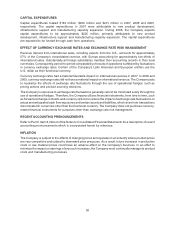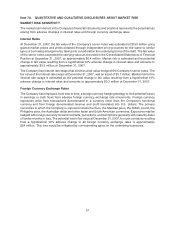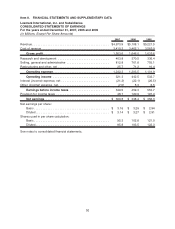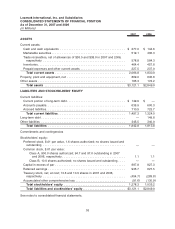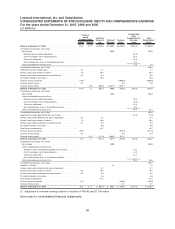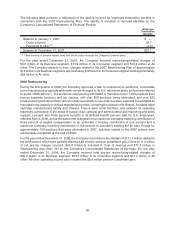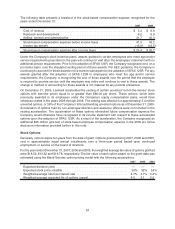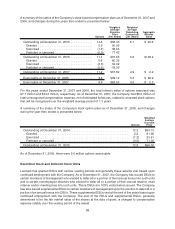Lexmark 2007 Annual Report Download - page 66
Download and view the complete annual report
Please find page 66 of the 2007 Lexmark annual report below. You can navigate through the pages in the report by either clicking on the pages listed below, or by using the keyword search tool below to find specific information within the annual report.The rate of compensation increase is determined by the Company based upon its long-term plans for such
increases. Effective April 2006, this assumption is no longer applicable to the U.S. pension plan due to the
benefit accrual freeze in connection with the Company’s 2006 restructuring actions. Unrecognized
actuarial gains and losses that fall outside the “10% corridor” are amortized on a straight-line basis
over the remaining estimated service period of active participants. The Company has elected to continue
using the average remaining service period over which to amortize the unrecognized actuarial gains and
losses on the frozen U.S. plan.
The Company’s funding policy for its pension plans is to fund the minimum amounts according to the
regulatory requirements under which the plans operate. From time to time, the Company may choose to
fund amounts in excess of the minimum for various reasons.
The Company accrues for the cost of providing postretirement benefits such as medical and life insurance
coverage over the remaining estimated service period of participants. These benefits are funded by the
Company when paid.
Effective December 31, 2006, the Company adopted Statement of Financial Accounting Standards
(“SFAS”) No. 158, Employers’ Accounting for Defined Benefit Pension and Other Postretirement Plans,
an amendment of FASB Statements No. 87, 88, 106, and 132(R) (“SFAS 158”). SFAS 158 requires
recognition of the funded status of a benefit plan in the statement of financial position and recognition in
other comprehensive earnings of certain gains and losses that arise during the period, but are deferred
under pension accounting rules.
Stock-Based Compensation:
On January 1, 2006, the Company implemented the provisions of SFAS No. 123 (revised 2004), Share-
Based Payment (“SFAS 123R”) and related interpretations. SFAS 123R requires that all share-based
payments to employees, including grants of stock options, be recognized in the financial statements based
on their fair value. The Company selected the modified prospective transition method for implementing
SFAS 123R and began recognizing compensation expense for stock-based awards granted on or after
January 1, 2006, plus any unvested awards granted prior to January 1, 2006. Under this transition method,
prior periods have not been restated. Stock-based compensation expense for awards granted on or after
January 1, 2006, is based on the grant date fair value calculated in accordance with the provisions of
SFAS 123R. Stock-based compensation related to any unvested awards granted prior to January 1, 2006,
is based on the grant date fair value calculated in accordance with the original provisions of SFAS No. 123,
Accounting for Stock-Based Compensation. The fair value of the Company’s stock-based awards, less
estimated forfeitures, is amortized over the awards’ vesting periods on a straight-line basis.
Prior to the adoption of SFAS 123R on January 1, 2006, the Company accounted for the costs of its stock-
based employee compensation plans under Accounting Principles Board (“APB”) Opinion No. 25,
Accounting for Stock Issued to Employees (“APB 25”), and related interpretations. Under APB 25,
compensation cost was not recognized for substantially all options granted because the exercise price
was at least equal to the market value of the underlying common stock on the date of grant.
The fair value of each option award on the grant date was estimated using the Black-Scholes option-pricing
model with the following assumptions: expected dividend yield, expected stock price volatility, weighted
average risk-free interest rate and weighted average expected life of the options. Under SFAS 123R, the
Company’s expected volatility assumption used in the Black-Scholes option-pricing model was based
exclusively on historical volatility and the expected life assumption was established based upon an
analysis of historical option exercise behavior. The risk-free interest rate used in the Black-Scholes model
was based on the implied yield currently available on U.S. Treasury zero-coupon issues with a remaining
term equal to the Company’s expected term assumption. The Company has never declared or paid any
cash dividends on the Class A Common Stock and has no current plans to pay cash dividends on the
Class A Common Stock. The payment of any future cash dividends will be determined by the Company’s
board of directors in light of conditions then existing, including the Company’s earnings, financial condition
60


